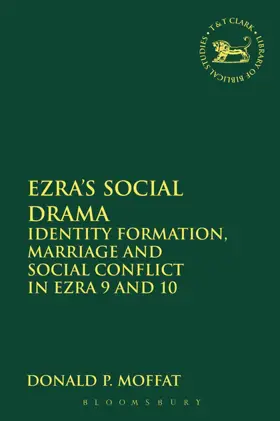

Ezra's Social Drama: Identity Formation, Marriage and Social Conflict in Ezra 9 and 10
in Library of Hebrew Bible/Old Testament Studies
Pages
208
Publisher
T&T Clark
Published
2014
ISBN-13
9780567657442
Moffat aims to provide further insight into the mixed marriage narrative by exposing the social and cultural factors on
which it is based. He also identifies historical traces in the narrative that can contribute to a historical reconstruction
of the post-exilic era. The socio-cultural analysis highlights previously unobserved aspects of the narrative as it
understands that the narrative reflects a context in which identity formation issues were prominent in Persian Yehud.
Moffat argues that the rituals of mourning and penitential prayer are important acts that shaped the mixed marriage
controversy. The label ‘foreign women' is identified as a symbol which carried considerable freight and connected the
mixed marriages with wider social discourse on identity. Further, the Exodus traditions are shown to be significant for
the conceptual foundations underlying the narrative and the society that produced it. The analysis also gives reason to
understand Ezra as the pivotal character in narrative plot. This not only affects how the narrative is understood but has
implications for historical reconstruction that utilises this narrative.
- Table Of Contents
- Acknowledgements
- Abbreviations
- Introduction: Ezra's Social Drama
- Chapter 1. Social Science, Historicity and Identity
- 1. Social Sciences and Biblical Studies
- a. Applying Social Science
- b. Turner and Social Drama
- c. Social Drama: Phases, Root Paradigms, Ritual and Symbolism
- d. Social Drama and Biblical Studies
- e. Social Science Summary
- 2. Ezra-Nehemiah and Historical Reconstruction
- 3. Identity
- a. Identity Formation
- b. Identity Formation as Context
- 4. Summary
- 1. Social Sciences and Biblical Studies
- Chapter 2. Yehud
- 1. Issues in Mapping Yehud
- 2. The Extent of Yehud
- 3. The Population of Yehud
- 4. Political Status
- 5. Summary
- Chapter 3. Foundations for Reading Ezra 9 and 10
- 1. Nehemiah 8 and Ezra 7-10
- a. Nehemiah 8 Displaced
- b. The Original Position of Nehemiah 8
- 2. The Unity of Ezra 9 and 10
- a. The Original Debate About Unity
- b. Recent Source-Critical Studies
- c. Summary
- 1. Nehemiah 8 and Ezra 7-10
- Chapter 4. Ezra 9 and 10
- 1. The Problem Identified (Ezra 9:1-5)
- a. The Report
- b. Leaders and Israel
- c. The Peoples of the Land(s)
- d. Marriage is the Problem
- e. Ezra's Reaction
- 2. Ezra's Penitential Prayer (Ezra 9:6-15)
- a. Pentitential Prayers
- b. Ezra's Prayer
- c. Shame, History and Mercy (Ezra 9:6-9)
- d. Guilt Before God (Ezra 9:10-15)
- 3. The People's Response (Ezra 10:1-44)
- a. Loaded Words
- b. Community Action
- c. Dissolving the Mixed Marriages
- d. Summary
- e. Concluding the Issue (Ezra 10:18-44)
- 4. Summary
- 1. The Problem Identified (Ezra 9:1-5)
- Chapter 5. The Mixed Marriage Social Drama
- 1. Elements of a Social Drama
- 2. Mixed Marriage and Identity Formation
- 3. The Exodus as Root Paradigm
- a. The Exodus in Ezra
- b. The Exodus as Root Paradigm
- 4. Foreign Women as Symbol
- a. Symbol, Turner and Semiotics
- b. Connotations of Foreign Women
- c. Powerful Symbols
- d. Summary
- 5. The Mixed Marriage Narrative as Social Drama
- a. Breach
- b. Crisis
- c. Redressive Action
- d. Reintegration
- Chapter 6. Historical Traces
- 1. Indications of Historicity
- 2. Historical Traces
- a. The Exodus Paradigm in Post-Exilic Yehud
- b. Ezra the Catalyst
- c. Social Discourse and Foreign Women
- d. A Witch Hunt?
- e. Conformity to the Commission's Demands
- f. Residual Effect
- 3. Summary
- Conclusions
- Bibliography
- Index of References
- Index of Authors